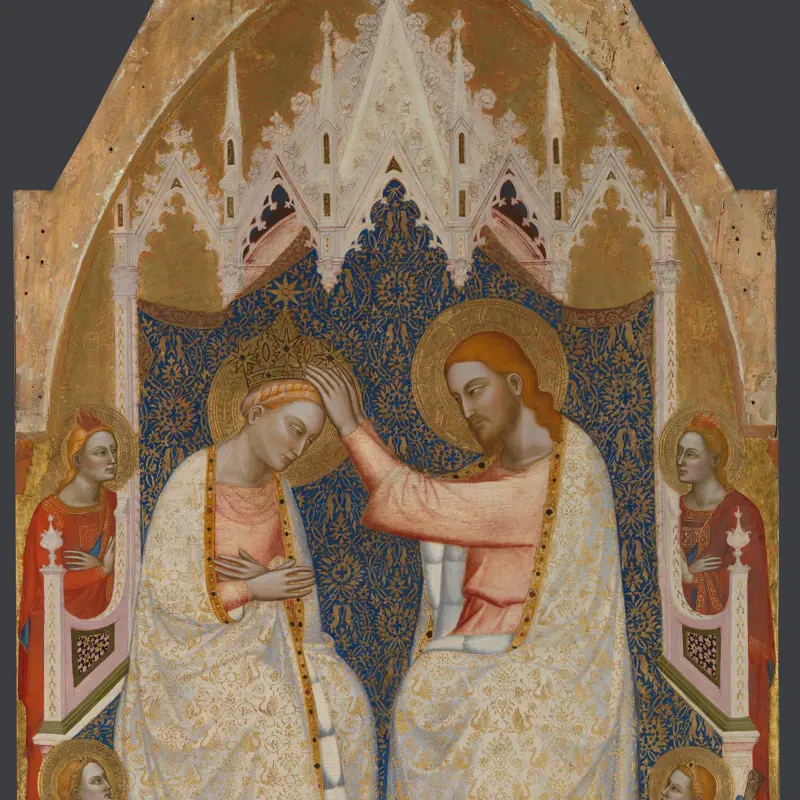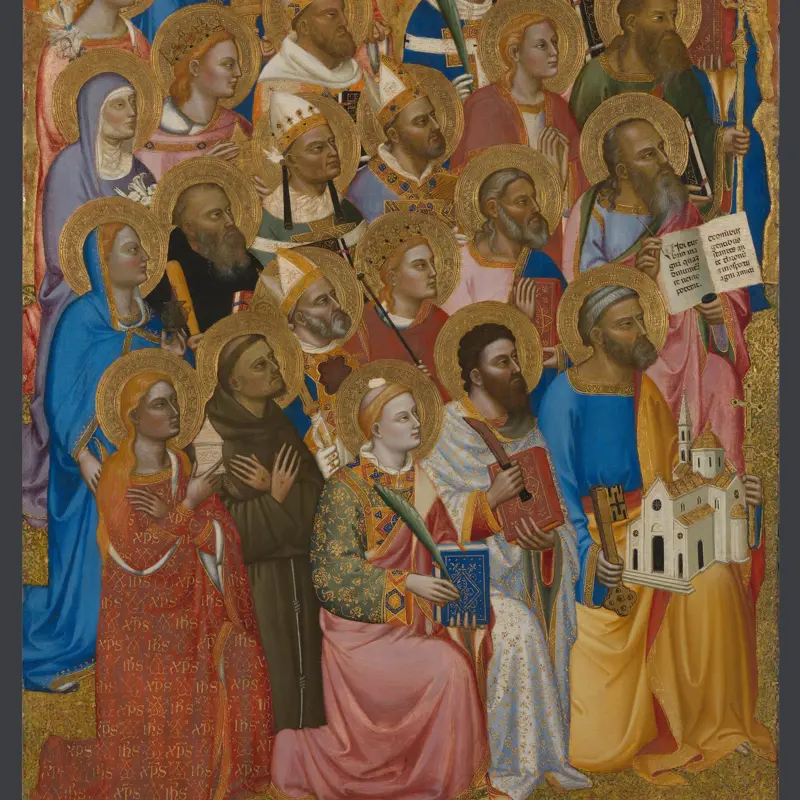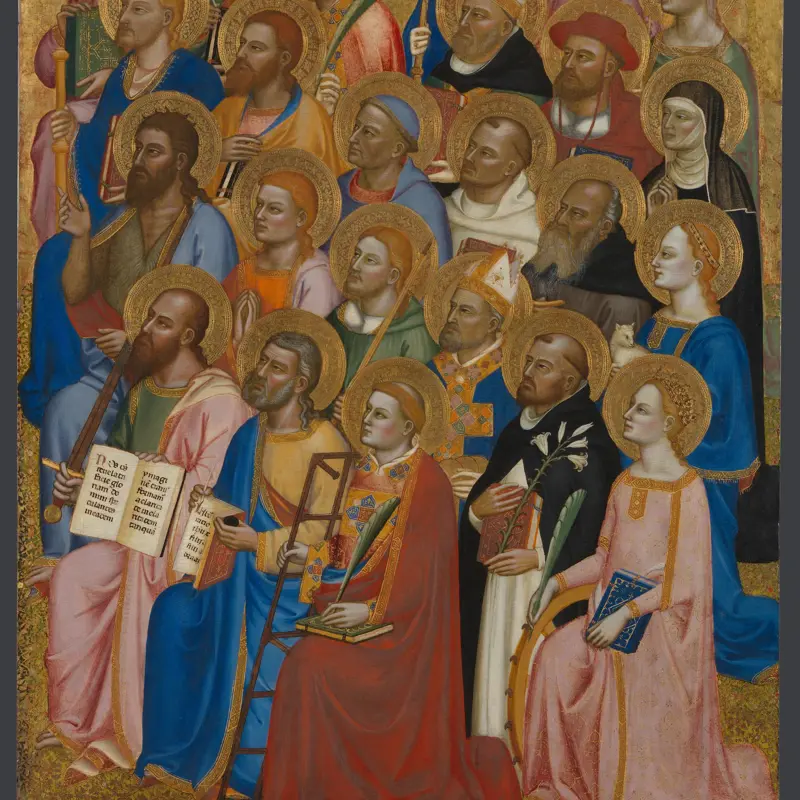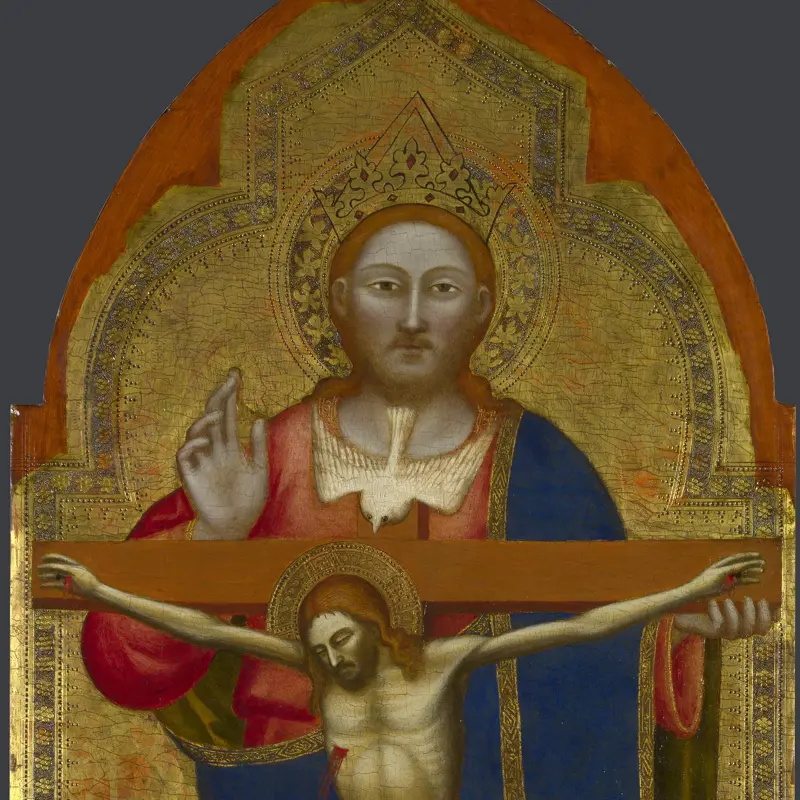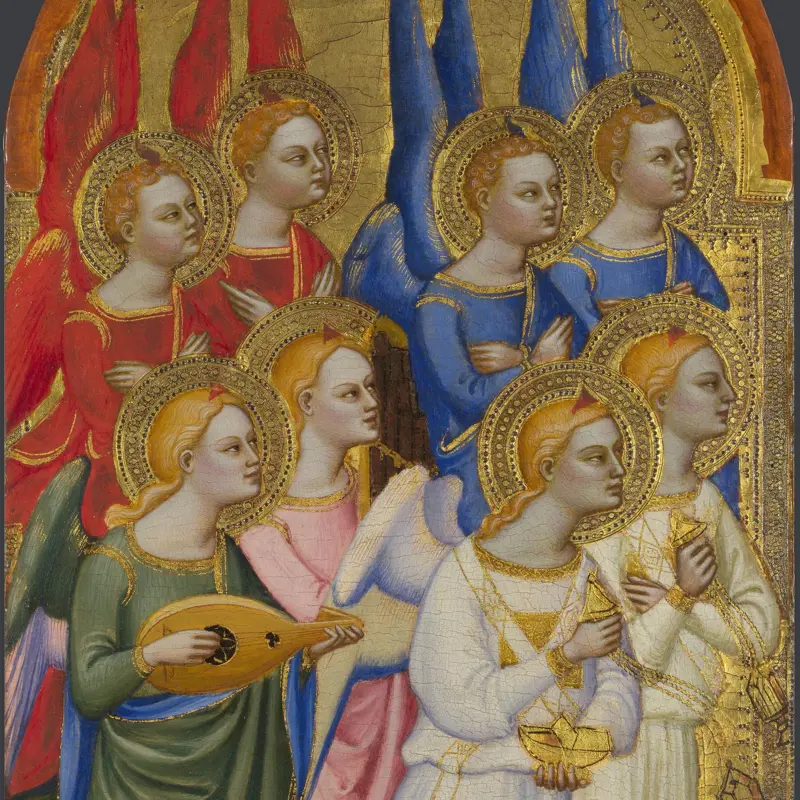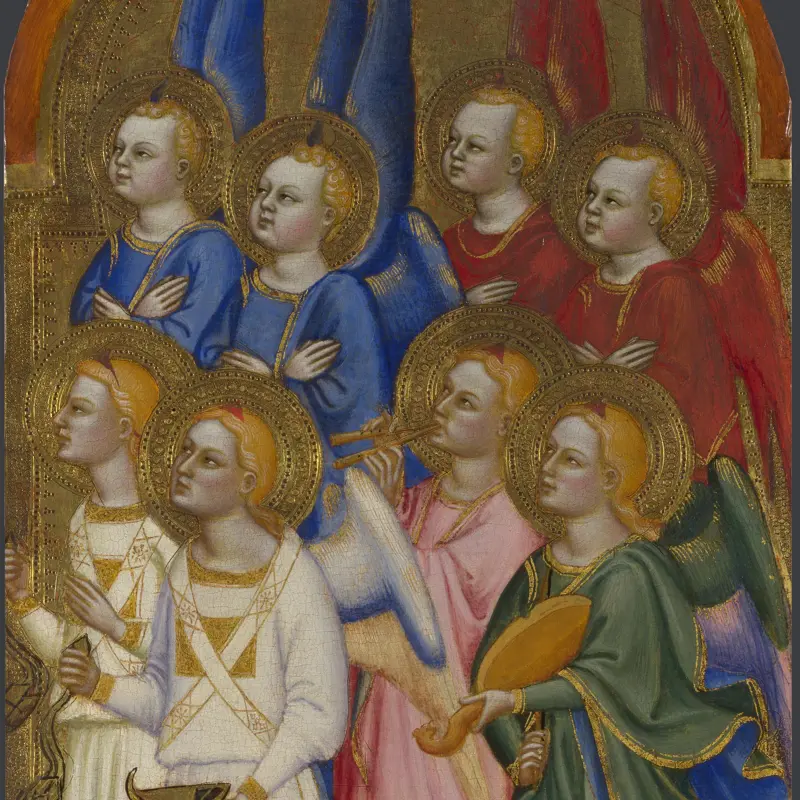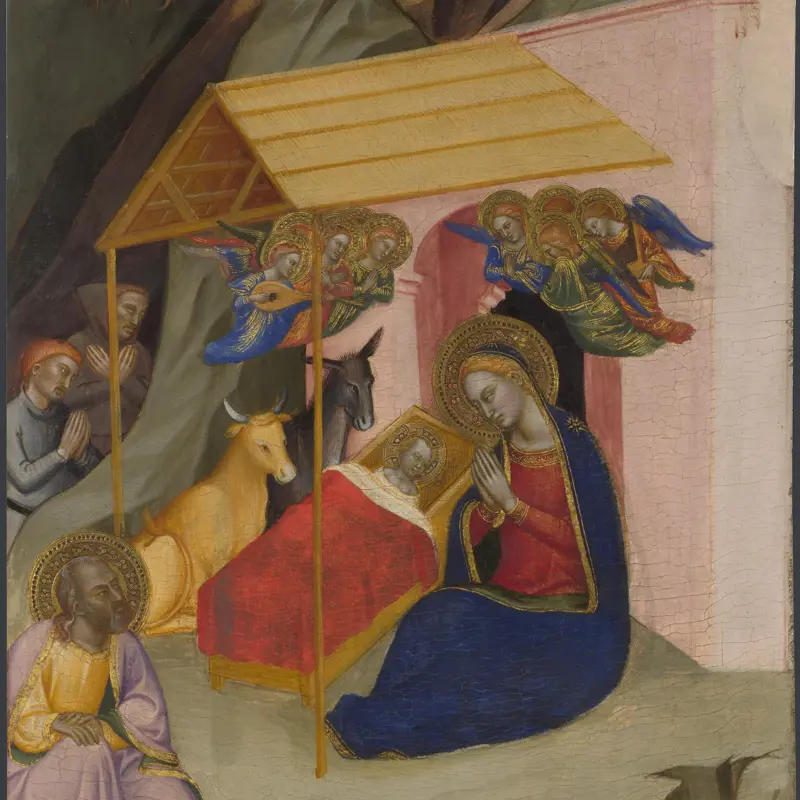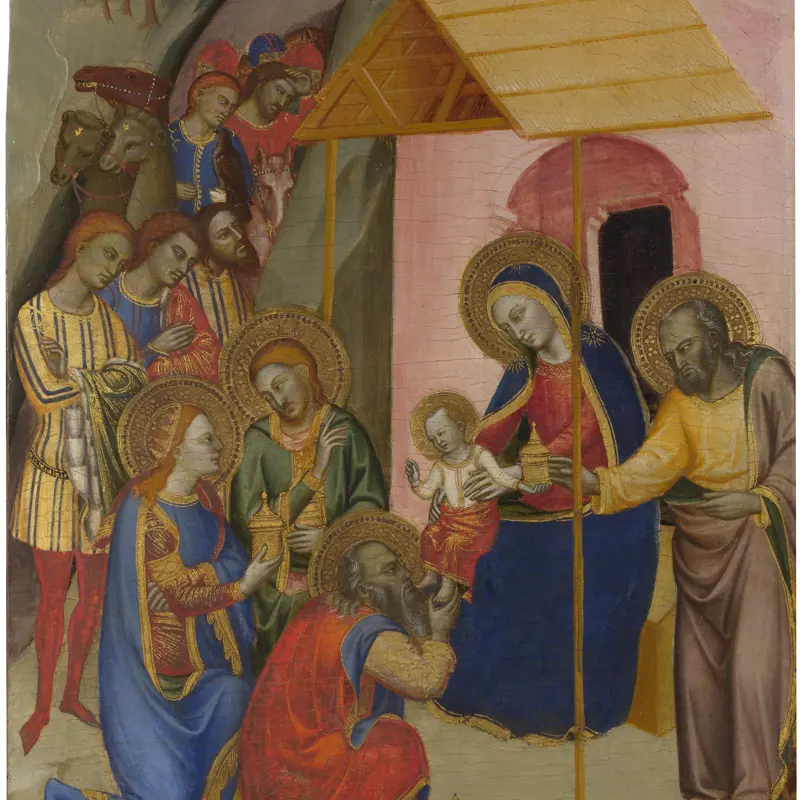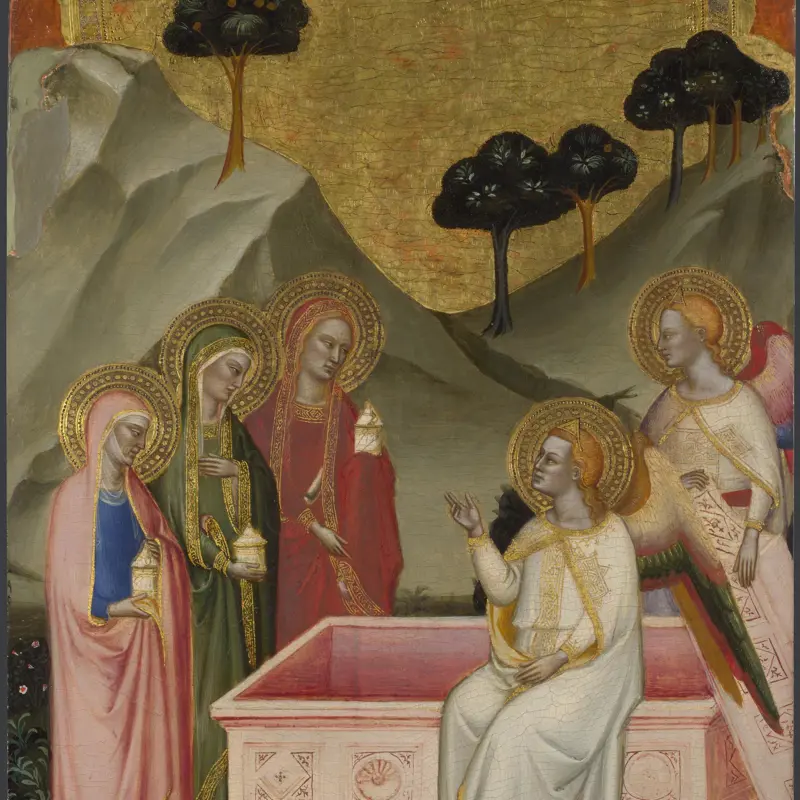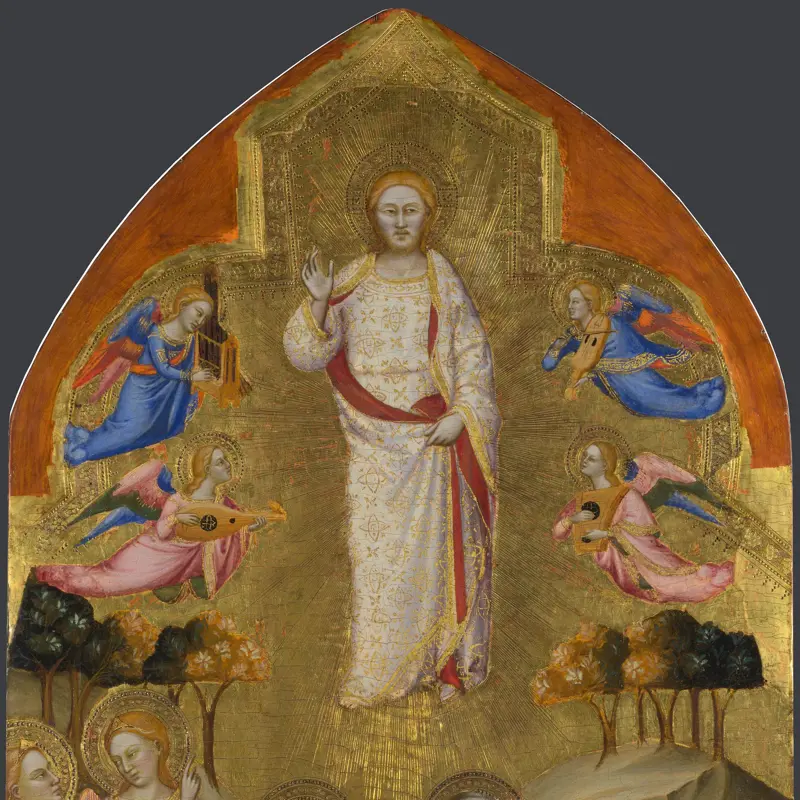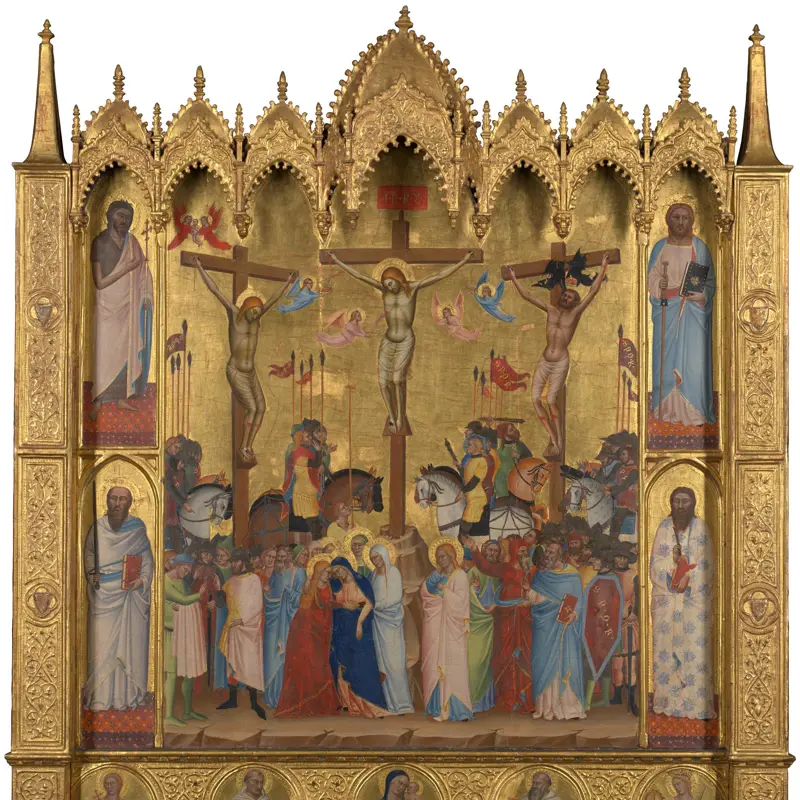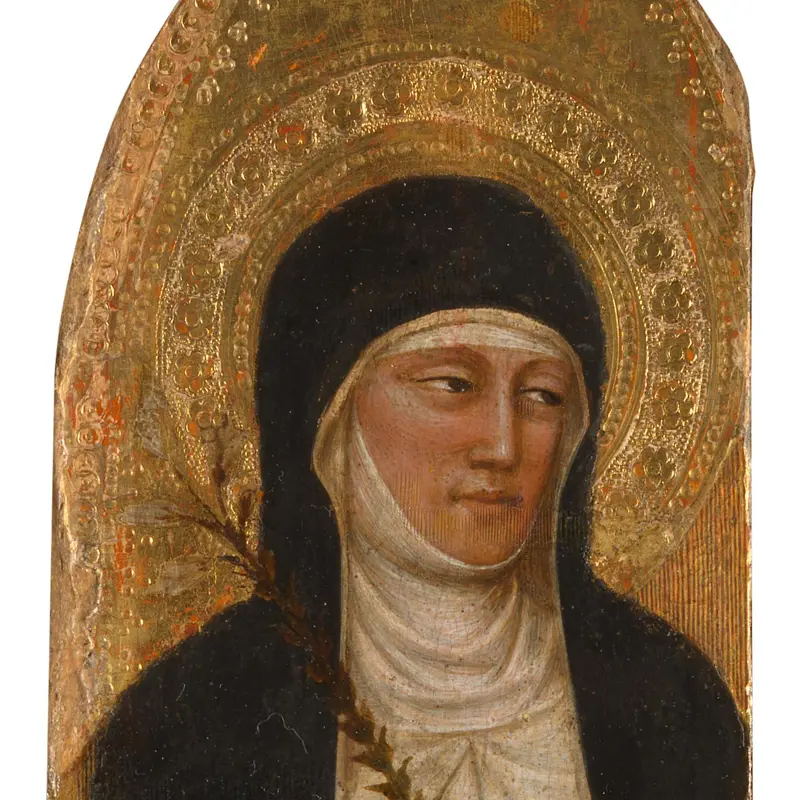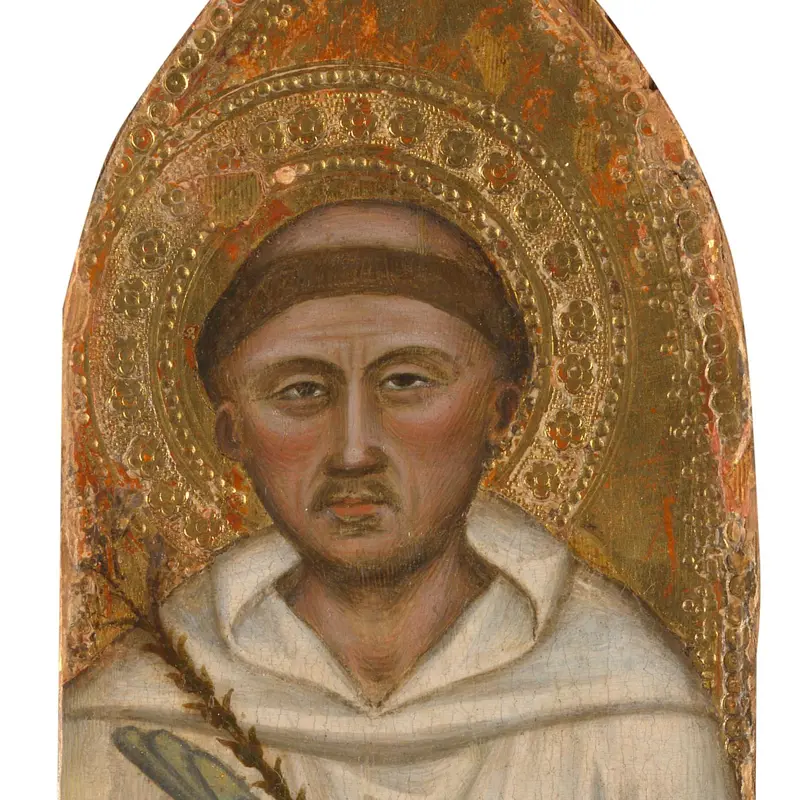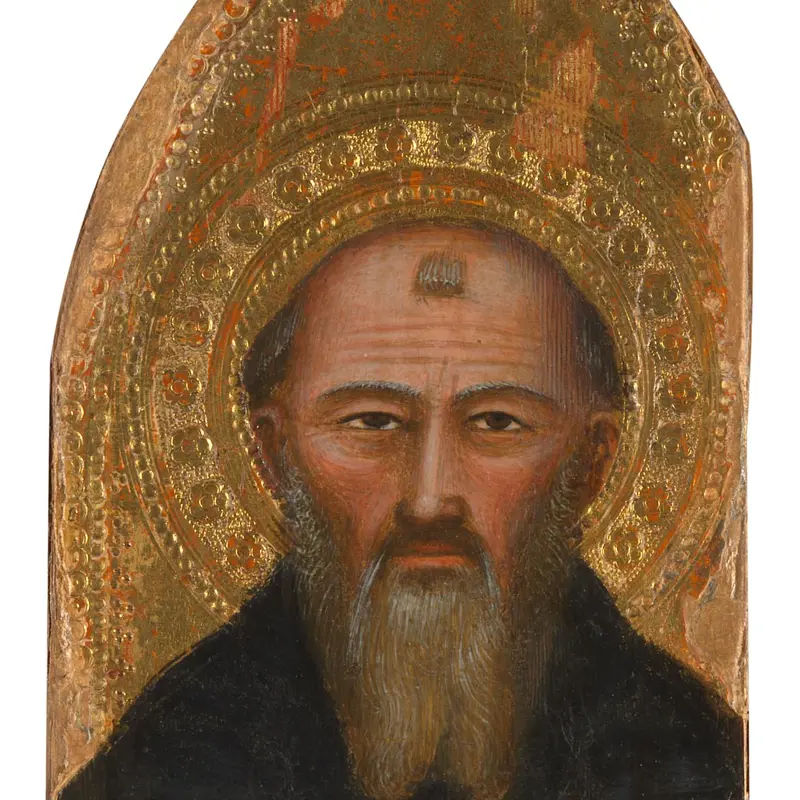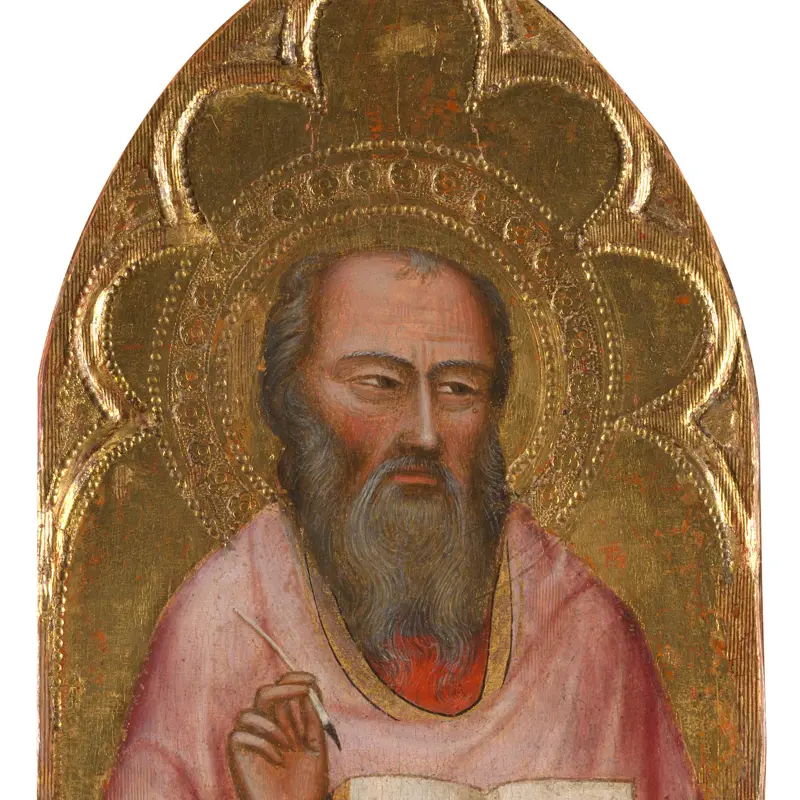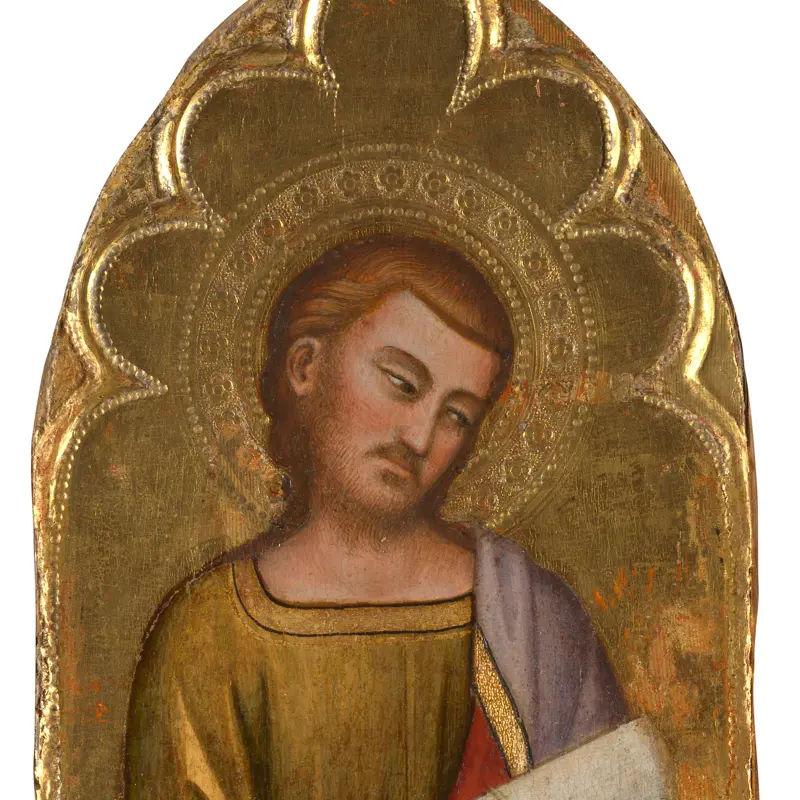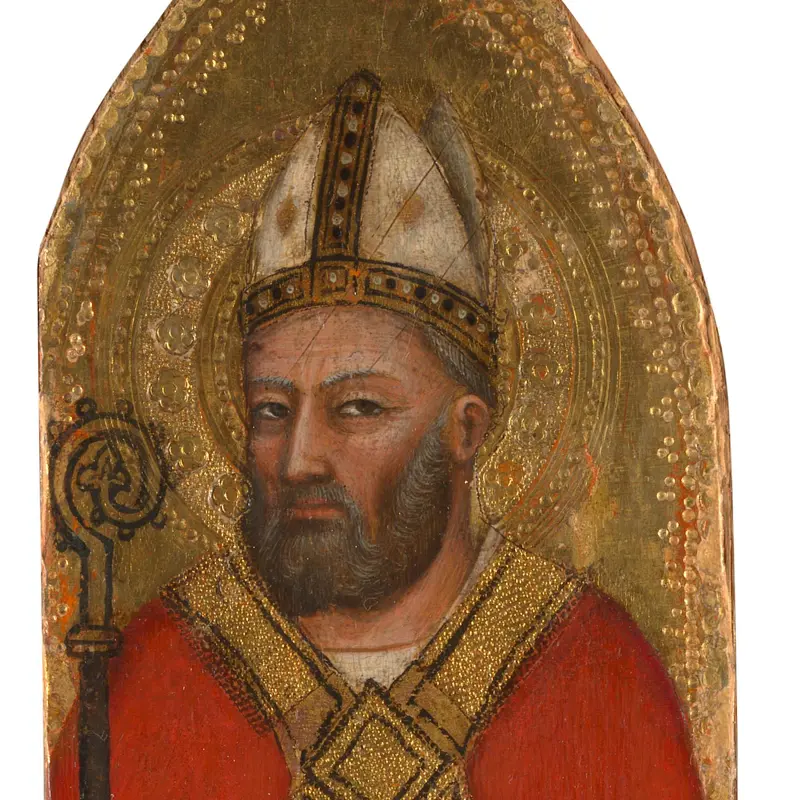Jacopo di Cione and workshop, 'The Trinity: Central Pinnacle Panel', 1370-1
About the work
Overview
This was once the central and uppermost part of a multi-panelled altarpiece, made for the church of San Pier Maggiore in Florence. Although it would have been displayed very high, right at the top of this large altarpiece, the limited colours, bold shapes and simple design mean it would have been visible and legible to those standing below.
The image shows God the Father making a blessing gesture and holding the Cross upon which hangs the crucified Christ, his son; between them is the Holy Ghost in the form of a dove.
Key facts
Details
- Full title
- The Trinity: Central Pinnacle Panel
- Artist
- Jacopo di Cione and workshop
- Artist dates
- Documented 1365, died 1398 -1400
- Part of the series
- The San Pier Maggiore Altarpiece
- Date made
- 1370-1
- Medium and support
- Egg tempera on wood (probably poplar)
- Dimensions
- 89.2 × 40 cm
- Acquisition credit
- Bought, 1857
- Inventory number
- NG570
- Location
- Room 57
- Collection
- Main Collection
Provenance
Additional information
Text extracted from the ‘Provenance’ section of the catalogue entry in Dillian Gordon, ‘National Gallery Catalogues: The Italian Paintings before 1400’, London 2011; for further information, see the full catalogue entry.
Exhibition history
-
2015Visions of Paradise: Botticini's Palmieri AltarpieceThe National Gallery (London)4 November 2015 - 14 February 2016
Bibliography
-
1677F. Bocchi and G. Cinelli, Le bellezze della città di Fiorenza, dove a pieno di pittvra di scvltvra di sacri templi di palazzi, i piu notabili artifizj, e piu preziosi si contengono, Florence 1677
-
1754G. Richa, Notizie istoriche delle chiese fiorentine, 10 vols, Florence 1754
-
1845F. Moisè, Santa Croce di Firenze: Illustrazione storico-artistica, con note e copiosi documenti inediti, Florence 1845
-
1854G. Milanesi, Documenti per la storia dell'arte senese, 3 vols, Siena 1854
-
1859R.N. Wornum, Descriptive and Historical Catalogue of the Pictures in the National Gallery with Biographical Notices of the Painters: Foreign Schools, 29th edn, London 1859
-
1878G. Vasari, Le vite de'più eccellenti pittori, scultori ed architettori: Con nuove annotazioni e commenti di Gaetano Milanesi, ed. G. Milanesi, 8 vols, Florence 1878
-
1887M.-F. Reiset, Une visite à la Galerie nationale de Londres, 2nd revised edn, Rapilly 1887
-
1930R. Offner and K. Steinweg, A Critical and Historical Corpus of Florentine Painting, 8 vols, New York 1930
-
1940W. Paatz and E.V. Paatz, Die Kirchen von Florenz: Ein hunstgeschichtliches Handbuch: S. Miniato al Monte, 5 vols, Frankfurt am Main 1940
-
1945H.D. Gronau, 'The San Pier Maggiore Altarpiece: A Reconstruction', The Burlington Magazine, LXXXVI, 1945, pp. 139-44
-
1947R. Offner, 'A Florentine Panel in Providence and a Famous Altarpiece', Studies, 1947, pp. 43-61
-
1951Davies, Martin, National Gallery Catalogues: The Earlier Italian Schools, London 1951
-
1979C. Gardner von Teuffel, 'The Buttressed Altarpiece: A Forgotten Aspect of Tuscan Fourteenth-Century Altarpiece Design', Jahrbuch der Berliner Museen, XXI, 1979, pp. 21-65
-
1986Davies, Martin, National Gallery Catalogues: The Earlier Italian Schools, revised edn, London 1986
-
1988Gordon, Dillian, National Gallery Catalogues: The Early Italian Schools before 1400, revised edn, London 1988
-
1988National Gallery, 'Pictures Cleaned and Restored in the Conservation Department of the National Gallery, 1987', National Gallery Technical Bulletin, XII, 1988
-
1989National Gallery, 'Pictures Cleaned and Restored in the Conservation Department of the National Gallery, January 1989 – October 1992', National Gallery Technical Bulletin, XIV, 1993, pp. 95-6
-
1989D. Bomford et al., Italian Painting before 1400 (exh. cat. The National Gallery, 29 November 1989 - 28 February 1990), London 1989
-
1991M. Finch, 'Petrine Landmarks in Two Predella Panels by Jacopo di Cione', Artibus et historiae, XII/23, 1991, pp. 67-82
-
1993R. White and J. Pilc, 'Analyses of Paint Media', National Gallery Technical Bulletin, XIV, 1993, pp. 86-94
-
1994E.S. Skaug, Punch Marks from Giotto to Fra Angelico: Attribution, Chronology and Workshop Relationships in Tuscan Panel Painting, With Particular Consideration to Florence c.1330-1430, Oslo 1994
-
1994A. Thomas, An Illustrated Dictionary of Narrative Painting, London 1994
-
1995D. Norman, '"Hail most Saintly Lady": Change and Continuity in Marian Altarpieces', in D. Norman (ed.), Siena, Florence and Padua: Art, Society and Religion, 1280-1400, New Haven 1995, vol. 2, pp. 195-215
-
2001
C. Baker and T. Henry, The National Gallery: Complete Illustrated Catalogue, London 2001
-
2007J.R. Sale, 'Birds of a Feather: The Medici "Adoration" Tondo in Washington', The Burlington Magazine, CXLIX/1246, 2007, pp. 4-15
-
2011Gordon, Dillian, National Gallery Catalogues: The Italian Paintings before 1400, London 2011
About this record
If you know more about this work or have spotted an error, please contact us. Please note that exhibition histories are listed from 2009 onwards. Bibliographies may not be complete; more comprehensive information is available in the National Gallery Library.
Images
About the series: The San Pier Maggiore Altarpiece
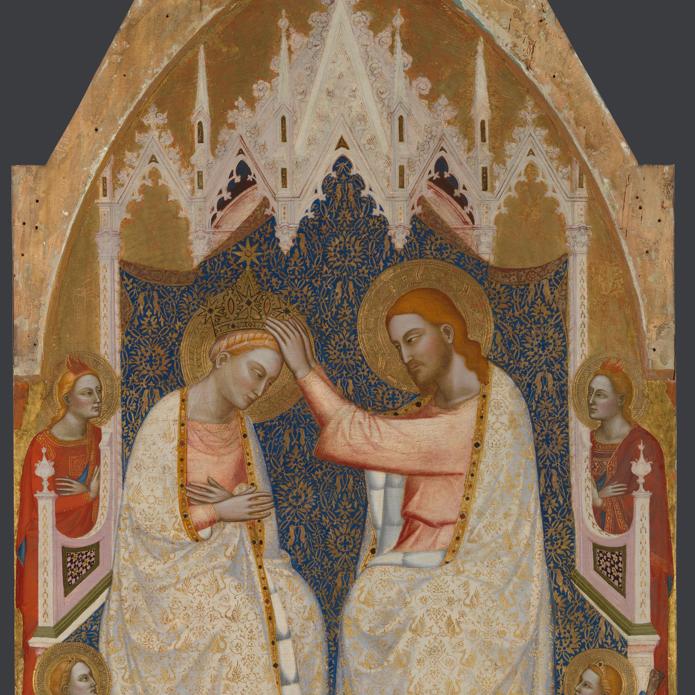
Overview
These images come from a large, four-tiered altarpiece created for the high altar of the choir of the church of San Pier Maggiore in Florence. It was made up of a number of separate panels, most of which are now in the National Gallery’s collection.
Although only the facade of the church remains today, it was one of the oldest and most important religious institutions in Florence when this altarpiece was made. It was founded by the first bishop of Florence, Saint Zenobius, in the fifth century. The picture formed the backdrop to one of the ceremonies relating to the ordination of each bishop of Florence until the late sixteenth century.
The altarpiece was most probably commissioned by the wealthy Florentine Albizzi family and many of its saints relate to their family or their trade as wool merchants. The central images showed the coronation of the Virgin by Christ surrounded by adoring saints – a highly popular image in Florence.

